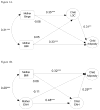Links between mothers' and children's disinhibited eating and children's adiposity
- PMID: 21182882
- PMCID: PMC3055954
- DOI: 10.1016/j.appet.2010.12.014
Links between mothers' and children's disinhibited eating and children's adiposity
Abstract
Few studies have examined relationships between parents' and children's specific disinhibited eating behaviors. We investigated links among mothers' and children's binge/loss of control eating, eating in the absence of hunger, and children's adiposity in 305 non-treatment-seeking youth, aged 8-17 years (13.62±2.65 years; 49.8% female) and their mothers. Youths' loss of control eating and eating in the absence of hunger were assessed by interview and self-report questionnaire. Children's adiposity was assessed with BMI-z and air displacement plethysmography. Maternal binge eating, eating in the absence of hunger and highest, non-pregnant BMI were self-reported. In structural equation models controlling for mothers' BMI, mothers' binge eating related to children's loss of control eating, and mothers' eating in the absence of hunger related to children's eating in the absence of hunger. Mothers' binge eating and children's eating in the absence of hunger were unrelated, as were mothers' eating in the absence of hunger and children's loss of control. Further, mothers' binge eating was indirectly related to children's adiposity through children's loss of control eating. Likewise, mothers' eating in the absence of hunger indirectly related to children's adiposity through children's eating in the absence of hunger. Mothers and children share similar, specific disinhibited eating styles.
Published by Elsevier Ltd.
Figures


References
-
- American Psychiatric Association. Diagnostic and statistical manual of mental disorders DSM-IV-TR. 4. Washington, DC: 2000.
-
- Birch LL, Davison KK. Family environmental factors influencing the developing behavioral controls of food intake and childhood overweight. Pediatric Clinics of North America. 2001;48(4):893–907. - PubMed
-
- Brown R, Ogden J. Children’s eating attitudes and behaviour: a study of the modelling and control theories of parental influence. Health Education Research. 2004;19(3):261–271. - PubMed
-
- Browne MW, Cudeck R. Alternative ways of assessing model fit. In: Bollen KA, Long JS, editors. Testing structural equation models. Beverly Hills: Sage Publications; 1993.
-
- Bryant-Waugh RJ, Cooper PJ, Taylor CL, Lask BD. The use of the eating disorder examination with children: a pilot study. International Journal of Eating Disorders. 1996;19(4):391–397. - PubMed
Publication types
MeSH terms
Grants and funding
LinkOut - more resources
Full Text Sources

